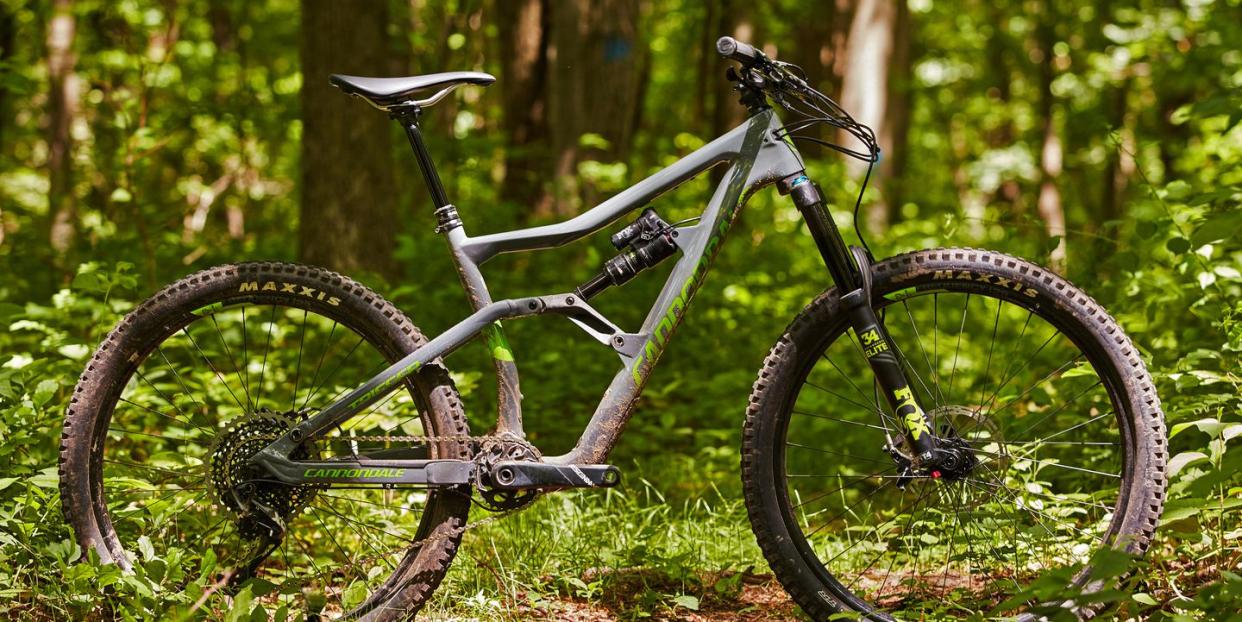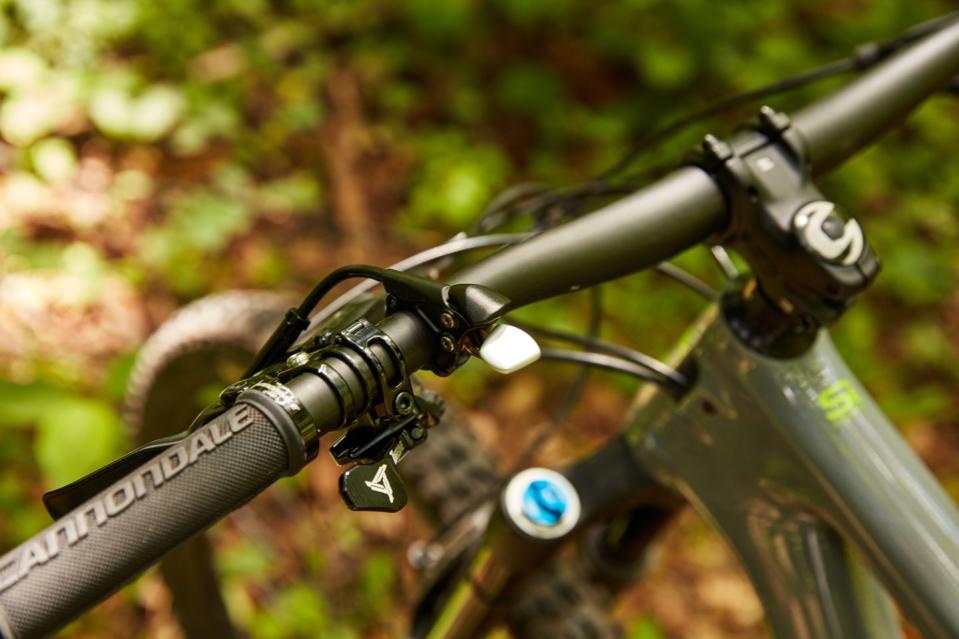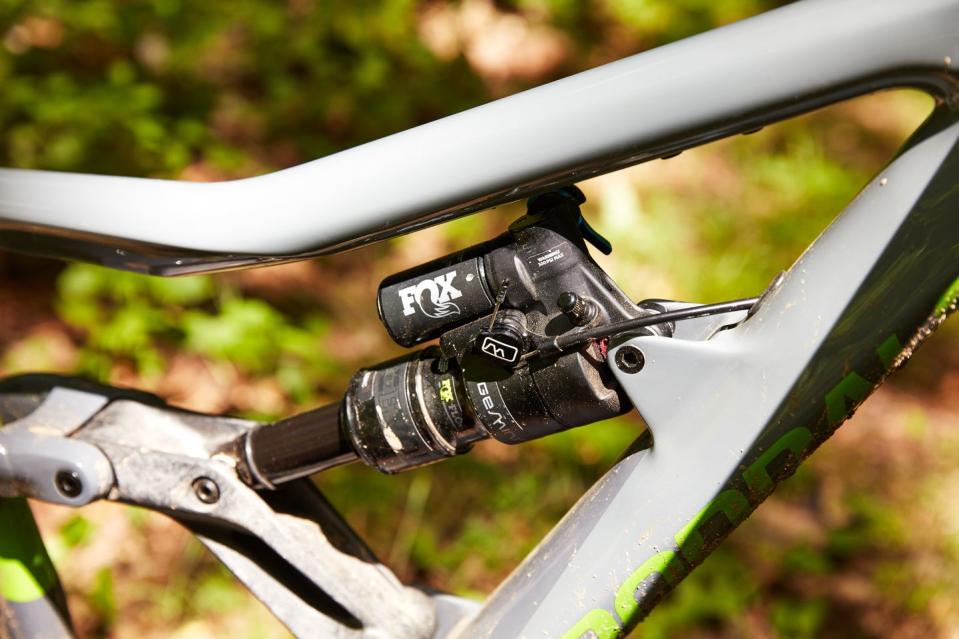The Trigger Climbs, Corners, and Rides Big Stuff

Price: $6,000
Weight: 28.8 lb.
Brakes: SRAM Guide RS hydraulic disc
Travel: 150mm (front); 145mm (rear, Flow Mode), 115mm (rear, Hustle Mode)
Suspension: Fox Float 34 Performance Elite fork; Fox Float X Performance Elite EVOL shock
Drivetrain: SRAM X01 Eagle 12-speed
The right bike for: riders who want an all-mountain bike that loves to climb
Thanks to its unique Gemini suspension system (developed in partnership with Fox), which lets the rider toggle between a 145mm-travel Flow mode and 115mm-travel Hustle mode, a rider can change the Cannondale Trigger 2’s characteristics on the fly, via a handlebar-mounted remote. At the higher setting, the Trigger 2 is a mid-travel, trail bike more at home on technical terrain and descents. In Hustle mode (a 20 percent reduction in shock volume from Flow mode), it becomes a stiff and agile XC bike more conducive to smoother trails and climbs.
SRAM Guide RS disc brakes provide excellent stopping power, and 27.5 x 2.3-inch Maxxis Minion tubeless-ready tires have the grip you need for whatever you encounter on the trail.
A SRAM X01 Eagle 12-speed drivetrain provides a generous gear range (500 percent from its 10-50t cassette) for tackling steep climbs and descents. Combined with the bike’s 74.5-degree seat-tube angle, which can help get you in a favorable climbing position, a RaceFace Turbine dropper post, which lets you dial in your position for descents, and excellent cornering ability, the Trigger 2 lives up to its do-it-all claim.

Multiple Options with Great Components
The $6,000 Trigger 2 sits in the middle of the three-bike range. The Trigger 3 is the lowest-priced model at $4,000. It’s built with the same carbon front triangle/aluminum rear triangle frame as the Trigger 2 but has lower-level components: a Shimano 1x11 drivetrain, Shimano SLX disc brakes, lower-grade WTB rims and Maxxis tires, and the less-expensive Trans X dropper. The $7,750 Trigger 1 is the top-end model and comes with a full carbon frame, higher-grade SRAM Eagle 12-speed drivetrain and Guide brakes, and carbon rims. Each version comes with a Fox 36 fork and Fox Float Gemini shock with travel adjust.
Hustle and Flow Rear Suspension
The Gemini remote-activated shock system distinguishes the Trigger 2 from most trail bikes. A handlebar remote switches the rear travel from 145mm (“Flow” in Cannondale speak) to 115mm (Hustle), and back again.
While in Hustle mode, the Fox Float X Performance shock reduces available travel from 145mm to 115mm and makes the shock more progressive for a firmer pedaling platform that feels more stable while climbing and transfers power better when pushing hard through flowy sections.
The remotes activates a piston inside the Fox Float shock that reduces the size of the shock’s air chamber, limiting total air volume. It doesn’t actually reduce the shock’s total travel, but it does make the air spring so progressive that the shock’s travel is effectively limited. The initial action of the shock will respond as it if it were in 145mm mode, but as you move farther through the travel, it becomes more progressive until it reaches its maximum travel of 115mm.
If you wanted to firm up the shock even more, a compression adjustment lever on the shock body locks it out almost completely.
Once the trail heads down again, switching to Flow mode lets the shock use its full air volume, so it can access every millimeter of stroke.
The Fox Float 34 Performance Elite fork with 110mm Boost axle spacing, designed for aggressive trail riders, is smooth, supple, and performs well over small bumps.

Geometry for Cornering
Geometry-wise, the Trigger 2 fits right in amongst other bikes in the all-mountain/trail category. Its 66-degree head-tube angle is on the relaxed side, but still steeper than than the Specialized Stumpjumper 27.5 (65.5 degrees–both bikes have 150mm forks with 44mm offset). The Trigger’s 74.5-degree seat-tube angle is on the steeper side. (Steeper seat-tube angles are en vogue, in part because they make it easier for a rider to achieve a more forward position, which helps keep the rider’s weight from getting too far back when climbing. This is particularly helpful for squishier, longer-travel bikes). The bottom bracket is relatively high at 345mm, which helps prevent crank strikes in rocky and off-camber terrain. The tradeoff is that the Trigger’s higher stance may feel a bit more unsettled, especially when descending. For comparison, the Giant Trance has a bottom bracket height of 333mm. If you’re a fan of shorter chainstays, the Trigger’s are only 420mm-12mm shorter than the Stumpjumper 27.5 and about 10mm shorter than a Pivot Mach 6.
The Trigger 2 stands out from other bikes in the category with its excellent cornering ability. On smooth, flowy trails, it holds its line; in tight, technical corners, the front end is easy to control and the rear can be whipped around. It does feel less stable than longer, slacker bikes on bigger terrain, but quick direction changes are what it does best.
Trigger Component Highlights
A 12-speed SRAM X01 Eagle drivetrain with a 10-50t cassette and 30-tooth chainring give the Trigger 2 the gear range to get up and over most climbs, and SRAM Guide RS hydraulic disc brakes with 180mm rotors front and rear provide reliable stopping power when charging down steep descents.
The Trigger 2 uses Cannondale’s proprietary Asymmetric Integration (Ai) rear-triangle offset. Essentially, the whole drivetrain is shifted 6mm farther outboard from the frame’s centerline. This is claimed to help designers achieve those short 420mm chainstays, as well as improve rear-wheel stiffness and reliability because of improved spoke-bracing angle. For the most part, Ai uses standard parts, but it does require a special rear-wheel dish and chainring offset, which may make it difficult to find replacement parts.
While not the fastest-rolling tires, the Maxxis Minion DHF and DHR II are durable, grippy, and perform well in all conditions.
Ride Impressions
The Trigger 2 handles rocky, rooty terrain well, and the 27.5x2.3-inch tires are big enough to roll over small rock gardens without hindering the bike’s maneuverability. With the shock open, the Trigger 2 is certainly capable of riding steeper, more technical terrain, but the short back end lacks the stability of longer bikes, and at times I would lose control through more difficult sections. The shorter wheelbase and steeper geometry seem better suited to trail riding, and I had the most fun on climbing sections of trail. While pedaling with Hustle mode engaged, the noticeable pedal bob is reduced significantly, and I was able to weave my way through sections that gave me more difficulty on longer bikes. I spent more time riding with Hustle mode engaged as I appreciated the lively feel of the bike and opened up the shock to get me through occasional enduro-style sections.
You Might Also Like

